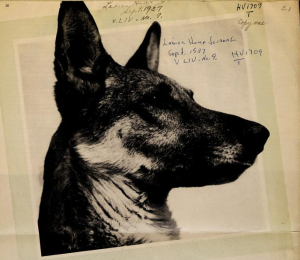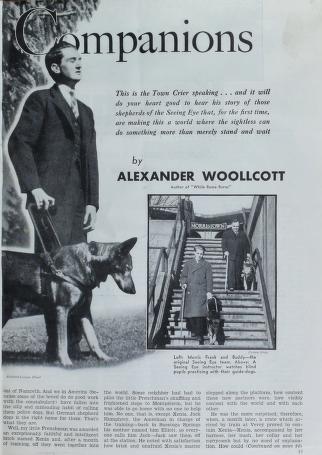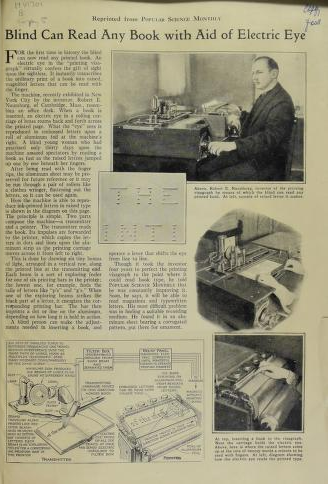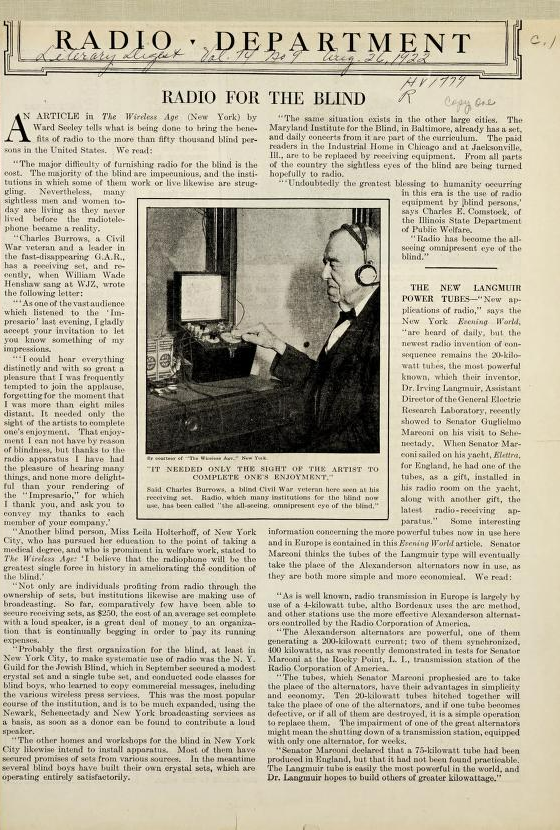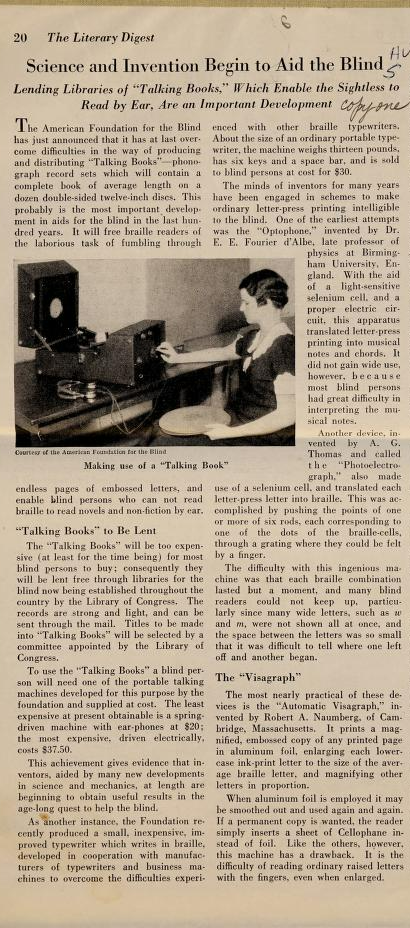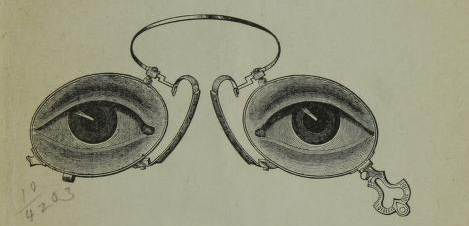
~Rachael Gillibrand, MHL Jaipreet Virdi Fellow for Disability Studies, 2021
According to the World Health Organisation, at least 2.2 billion people around the world have some kind of visual impairment. These impairments are classified by the ‘International Classification of Diseases 11’ into distance vision impairments (sub-categorised into: Mild, Moderate, Severe, and Blindness) and and near presenting vision impairments. Today, many of these conditions can be treated relatively cheaply through the use of spectacles or contact lenses.
This primary source set will be divided into three main parts – each considering a different kind of technology used by individuals with ocular impairments. To begin with, it will discuss the development and use of spectacles – arguably the most ubiquitous of ocular technologies in the modern world. Then it will move on to discuss guide dogs, asking whether a living creature can even be labelled as a ‘technology’. Finally, it will discuss a range of reading technologies marketed throughout the late nineteenth and early twentieth centuries.
- Spectacles
- Prescribing Spectacles
- Dangers of Using Spectacles
Spectacles
Spectacles
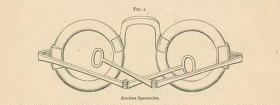
According to projections from the Vision Council, around 164 million American adults wear spectacles! In fact, of all the devices included in these ‘Disability and Technology’ source sets, spectacles (or glasses) are arguably one of the most ubiquitous forms of assistive technologies. As such, there is a huge amount of information pertaining to their construction, use and dangers, in the Medical Heritage Library’s collections.
However, the use of spectacles has a much longer tradition than most people realise. As Horner points out in his On Spectacles: Their History and Their Uses, magnifying lenses have been used as ocular aids since the ancient period. To demonstrate this, he cites Lanyard’s discovery of the Nimrud Lens, dating from 750 BC – 710 BC, as one of the earliest examples (this item is now held in the British Library and can be accessed here). However, it was not until the late thirteenth century, in Italy, that spectacles, as we might recognise them today, were invented.
The first textual reference to spectacles (discussed by George H. Oliver in his Address on the History of the Invention and Discovery of Spectacles) comes from the sermon of an Italian Friar named Giordano da Rivalto, delivered on February 23rd,1305. In this semon, Giordano stated that: ‘It is barely twenty years since the art of making spectacles which enable us to see better was introduced, one of the most useful arts in the world. I have myself seen and spoken to the man who first made them’ – but he does not reveal who this man might be. After this point, the demand for, and accessibility of, spectacles developed exponentially – resulting in the wide use of these items that we see today.
Prescribing Spectacles
Dangers of Using Spectacles
- Guide Dogs
- Training Guide Dogs
- Living with a Guide Dog
Guide Dogs
Guide Dogs
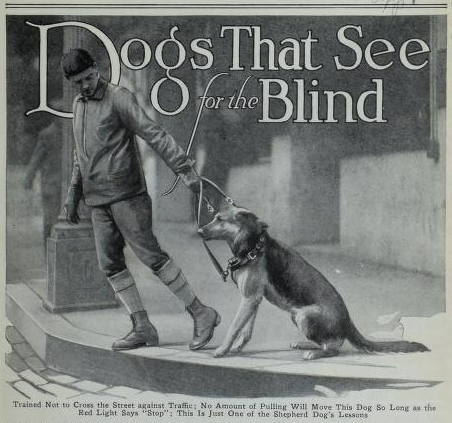
For as long as people and dogs have been living together, dogs have been used by blind people as assistive aids. For example, scholars such as Michael Tucker have argued that an image of a guide dog appears in a first-century AD mural in the ruins of Roman Herculaneum! We also find images of guide dogs in several medieval manuscripts (such as Walters Art Museum, MS 82, fol. 207r.), and later they appear in Victorian literature. Charles Dickens, for example, writes in A Christmas Carol that, ‘even the blind men’s dogs appeared to know him [Scrooge]; and when they saw him coming on, would tug their owners into doorways and up courts’. However, it was not until after the First World War that guide dogs began to be trained and issued en masse.
One of the early pioneers in the training of guide dogs en masse was Dorothy Harrison Eustis. Eustis was working as a dog breeder and trainer in Switzerland when she first heard that a large guide dog training centre had been set up in Potsdam, Germany. Intrigued by their methods, Eustis visited the centre for several months and later wrote in Dogs as Guides for the Blind that, ‘since the Great War, Germany has developed the training and use of these dogs on a very large scale and to-day almost every German war blinded soldier capable of handling a dog has one provided by the Government and receives an allowance for it’s maintenance’.
Inspired by this system, Eustis wrote an article about the Potsdam training centre for the Saturday Evening Post in 1928, stressing the independence that guide dogs could bring to people with ocular impairments. Shortly after publication, she received a letter from a young blind man named Morris S. Frank, asking how he might help to set up a similar institution in America. He stated that, ‘I wrote to Mrs. Eustis to find out where I could obtain such a dog she answered that it was true that these shepherds would do these things and that, while they could not be procured in America, she would be glad to have a dog trained for use under American conditions, and train me with the dog’. Frank took Eustice up on her offer and together they worked to train Buddy the Guide Dog. Buddy was so successful that Frank and Eustice subsequently worked together to found ‘The Seeing Eye’ guide dog school.
Training Guide Dogs
Living with a Guide Dog
- Reading Devices
- Braille
- The Electric Eye
- Radio
- Talking Books
Reading Devices
Reading Devices
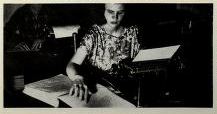
The final section of this Source Set will consider the development and use of ‘Reading Devices’. As we will see, the reading technologies discussed below could be divided into three categories: those that were specifically designed for individuals with visual impairments and used by said individuals; those that were not designed to function as disability technologies, but were rapidly taken up by individuals with visual impairments; and those that were designed to benefit the visually impaired community, but were taken up just as enthusiastically by individuals without visual impairments. As a result, this final section also serves to demonstrate the ways in which assistive aids influenced the development of technology more broadly (and vice versa).
Braille
The Electric Eye
Radio
Talking Books
Bibliography
Please find a list of the sources referenced in this set below.
- Ackland, W., Hints on Spectacles: When Required and How to Select Them (London: Horne & Thornthwaite, 1867)
- Aldous, Donald W., ‘Talking Books’, American Music Lover, 2:4 (1936)
- American Foundation for the Blind, Manuals for Instruction in Braille and Moon Type (New York: American Foundation for the Blind, 1958)
- Anon, ‘Blind Can Read Any Book with Aid of Electric Eye’, Popular Science Monthly, 119:1 (1931)
- Anon, ‘Books Talk: Records Carry Blind “Readers” Through Novels and Poetry Without Braille’, Literary Digest, 123:21 (1937)
- Anon, ‘Dogs that See for the Blind’, Popular Mechanics, 52:1 (1929)
- Anon, ‘Radio for the Blind’, Literary Digest, 74:9 (1922)
- Anon, ‘Science and Invention Begin to Aid the Blind: Lending Libraries of “Talking Books” Which Enable the Sightless to Read by Ear, Are an Important Development’, Literary Digest, 117:18 (1934)
- Anon, ‘Shepherd Dogs as Guides for the Blind’, House and Garden, 65:1 (1934)
- Anon, ‘What Radio Means to the Blind’, Town Crier (June 1929)
- Anon, ‘Why the Blind Nowadays Go to the Dogs to Guide Them in Their Darkness’, New York Sunday Mirror Magazine Section (June 26, 1932)
- Beer, Georg Josef, The Art of Preserving the Sight Unimpaired to an Extreme Old Age, and of Re-establishing and Strengthening it when it Becomes Weak (London: Printed for Henry Colburn, 1815)
- Bond, Frank Fraser, ‘Writ in Sound’, Saturday Review of Literature (January 28, 1939)
- Carter, Robert Brudenell, On Defects of Vision which are Remediable by Optical Appliances (London: MacMillan and Co., 1877)
- Chevigny, Hector, ‘My Eyes Have a Cold Nose’, Reader’s Digest, 45:270 (1944)
- Christensen, W. A., Almo, His Master’s Eyes: A True Story of a Famous Hero Eye Dog (Los Angeles: De Vorss & Co., 1935)
- Curtis, John Harrison, Observations on the Preservation of Sight, and on the Use, Abuse, and Choice of Spectacles (London: Renshaw & Rush, 1834)
- Eustis, Dorothy Harrison, Dogs as Guides for the Blind (Lausanne: Imprimerie Delacoste-Borgeaud, 1929)
- Fox, L. Webster, ‘A History of Spectacles’, Medical and Surgical Reporter (May 3, 1980), 1-7
- Hartwell, Dickson, ‘Training Seeing Eye Dogs’, Science Digest,13:1 (1943)
- Horner, Friedrich, On Spectacles: Their History and Their Uses (London: Ballière, Tindall & Cox, 1887)
- Kennedy, Isabel W., The Reconstruction of the Blind in France (Philadelphia: Pennsylvania Home Teaching Society and Free Circulating Library for the Blind, 1917)
- Loomis, Madeleine Seymour, You Can Learn to Read Braille: A Course in Reading Standard English Braille with the Assistance of Any Sighted Reader (New York: The New York Institute for the Education of the Blind, 1939)
- Moon, Robert C., ‘The Moon Type for the Blind’, St Nicholas (May 1910)
- Moschzisker, F. A. von, Spectacles: Why and When to Use Them, or, Near and Far-Sightedness: The Use and Abuse of Glasses (Baltimore: Printed by Hedian & O’Brien, 1856)
- Noyes, Henry Drury, How to Choose Glasses: Being Suggestions to Practical Opticians (New York: William Wood, 1880)
- Oliver, George Henry, An Address on the History of the Invention and Discovery of Spectacles (London: British Medical Association, 1913)
- Percival, Archibald Stanley, The Prescribing of Spectacles (Bristol: John Wright & Sons, 1910)
- Pixley, C. H., The Eye, its Refraction and Accommodation: A Brief Description of the Mechanical Conditions which make Spectacles a Necessity (Freeport, ILL: Home Office, 1889)
- Resnick, Rose, ‘My Adventures with a Seeing Eye Dog’, Our Dogs, 1:3 (1942)
- RoBards, M. J., ‘Touching Sight’, Louisville and Nashville Employees Magazine, 25:7 (1949)
- Roosa, D. B. St. John, Defective Eyesight: The Principles of its Relief by Glasses (New York: The MacMillan Company, 1899)
- Sichel, Jules, Spectacles: Their Uses and Abuses in Long and Short Sightedness; and the Pathological Conditions Resulting from their Irrational Employment (Boston: Phillips, Sampson, 1850)
- Snyder, Mrs William A., ‘Talking Books for the Blind: Mrs. William A. Snyder Describes Invention of Great Service to Sightless: An Article for Inner Mission Month’, The Lutheran, 18:38 (1936)
- Tarkington, Booth, ‘The Seeing Eye Dog’, Ladies Home Journal, 54:9 (1937)
- The Seeing Eye Inc., Here is Freedom! (Morristown: The Seeing Eye Inc., 1934)
- Thorndyke, Harriet, ‘A New Pair of Eyes’, Family Circle, 6:1 (1935)
- Woollcott, Alexander, ‘The Good Companions’, Cosmopolitan Magazine (August 1936)






